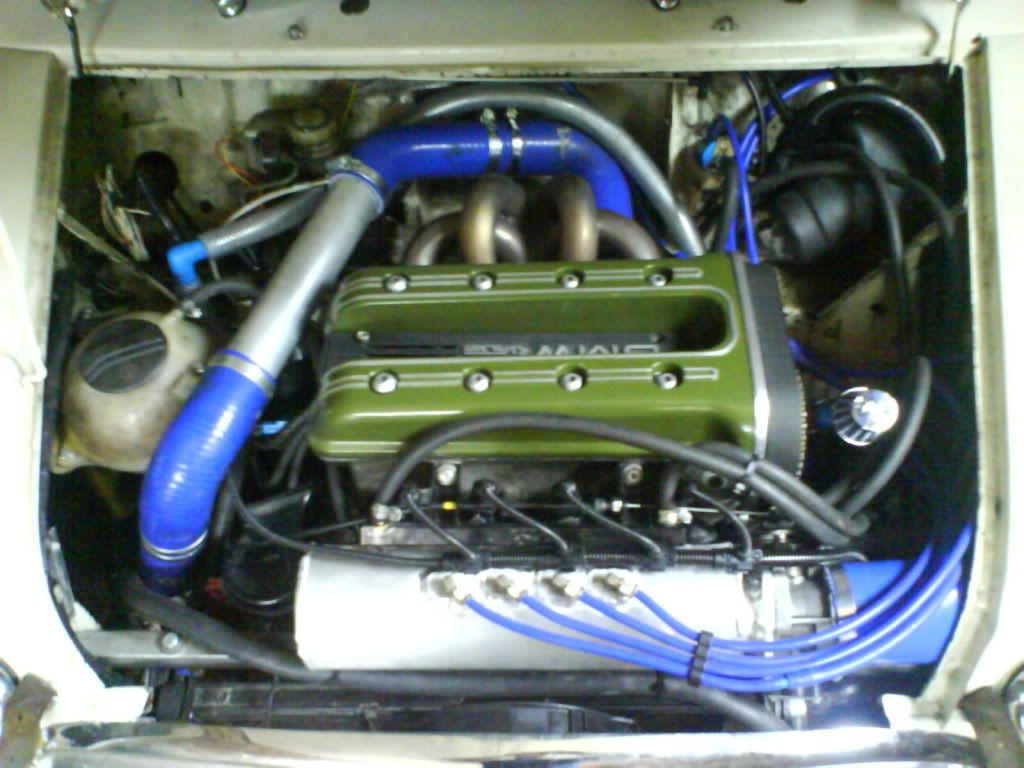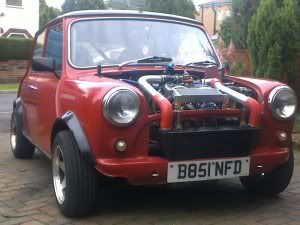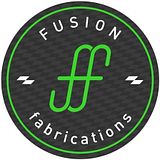| Page: |
| Home > Technical Chat > Monocoque construction using aluminium honeycomb | |||||||
|
8604 Posts Member #: 573 Formerly Axel Podland |
6th Oct, 2012 at 04:10:48pm
Also found this:
Edited by Paul S on 6th Oct, 2012. Saul Bellow - "A great deal of intelligence can be invested in ignorance when the need for illusion is deep."
|
||||||
 8297 Posts Member #: 408 Turbo Love Palace Fool Aylesbury |
6th Oct, 2012 at 09:03:38pm
How about spot welding it? https://www.facebook.com/pages/Fusion-Fabri..._homepage_panel
|
||||||
|
510 Posts Member #: 1592 Smart Guy! mainland europe near ze germans |
6th Oct, 2012 at 11:07:40pm
that fastener seems to turn the plate into a tapped ''insert'' by compressing the sheet quite a bit ( in the process hardening it as well i guess)
That sir, is not rust, it is the progressive mass reduction system
|
||||||
|
8604 Posts Member #: 573 Formerly Axel Podland |
7th Oct, 2012 at 08:42:49am
On 6th Oct, 2012 matty said:
How about spot welding it? Not an option as I'm talking about the very thin surface of a honeycomb sandwich plate over an inch thick at the healboard. Edited by Paul S on 7th Oct, 2012. Saul Bellow - "A great deal of intelligence can be invested in ignorance when the need for illusion is deep."
|
||||||
|
8604 Posts Member #: 573 Formerly Axel Podland |
7th Oct, 2012 at 08:49:10am
On 6th Oct, 2012 Sir Yun said:
maybe this is of use : http://www.f1technical.net/forum/viewtopic.php?f=5&t=5017 Why not use a fully composite panel? bonding composite to composite might be ''easier'' I prefer the idea of aluminium sandwich construction at this stage. Going fully composite is a big step on. I'd read that thread on the F1tech site the other day. They seem to be filleting the folds in the sandwich with carbon tape. I would prefer to use some thin aluminium strips and anti-peel rivets. Saul Bellow - "A great deal of intelligence can be invested in ignorance when the need for illusion is deep."
|
||||||
 11046 Posts Member #: 965 Post Whore Preston On The Brook |
7th Oct, 2012 at 09:32:04am
On 7th Oct, 2012 Paul S said:
On 6th Oct, 2012 matty said:
How about spot welding it? Not an option as I'm talking about the very thin surface of a honeycomb sandwich plate over an inch thick at the healboard. That's an oven brazed structure. I would't be surprised if could buy that in sheet, surely easier and more reliable to just buy it and cut it to any shape and size you wanted? On 26th Oct, 2004 TurboDave16v said:
Is it A-Series only? I think it should be... So when some joey comes on here about how his 16v turbo vauxhall is great compared to ours, he can be given the 'bird'... On 26th Oct, 2004 Tom Fenton said:
Yep I agree with TD........ |
||||||
|
8604 Posts Member #: 573 Formerly Axel Podland |
7th Oct, 2012 at 09:41:00am
On 7th Oct, 2012 Sprocket said:
That's an oven brazed structure. I would't be surprised if could buy that in sheet, surely easier and more reliable to just buy it and cut it to any shape and size you wanted? The picture was intended to represent a bonded structure with the honeycomb glued to the facing sheets, but that's not the issue. Cutting it to size and shape is easy. Joining the pieces together to form a chassis is where it gets complicated. I'm now sold on the idea of DIY glueing, but as Jean suggests, it would be a good idea to do some load testing of some glued joints before proceding. Just need some offcuts. Saul Bellow - "A great deal of intelligence can be invested in ignorance when the need for illusion is deep."
|
||||||
 12307 Posts Member #: 565 Carlos Fandango Burnham-on-Crouch, Essex |
7th Oct, 2012 at 10:25:47am
yep gluing....
On 28th Aug, 2011 Kean said:
At the risk of being sigged... Joe, do you have a photo of your tool? http://www.turbominis.co.uk/forums/index.p...9064&lastpost=1 https://joe1977.imgbb.com/ |
||||||
|
656 Posts Member #: 1917 AKA chargedzetec Milton Keynes |
7th Oct, 2012 at 02:08:06pm
You also need to consider that inserts will need to be put into the core to allow bolting up of structural pieces. You can't just bolt through the core.
This is FORD country, on a quiet day you can hear Vauxhalls rusting. |
||||||
|
8604 Posts Member #: 573 Formerly Axel Podland |
7th Oct, 2012 at 02:54:04pm
On 7th Oct, 2012 steve w said:
You also need to consider that inserts will need to be put into the core to allow bolting up of structural pieces. You can't just bolt through the core. There is some detail of suitable inserts in the Cardiff Racing write up linked above. However, for something like the rear radius arms, I was thinking along the lines of bonding and riveting a large thick plate to the sandwich plate to spread the load over a larger area. Same for the cage mounts etc. On 7th Oct, 2012 steve w said:
Are you planning on taking one piece of core, notching out the inner skin and folding the outer skin until the inner meets up again? Keeping the outside of the joint intact? (this makes sense in my head, even if I haven't described it well!?) Yes, imagine the floor being a series of longitudinal folds to construct the cills and exhaust tunnel. Angle plates bonded at the inside of the fold. Saul Bellow - "A great deal of intelligence can be invested in ignorance when the need for illusion is deep."
|
||||||
 8297 Posts Member #: 408 Turbo Love Palace Fool Aylesbury |
7th Oct, 2012 at 09:14:58pm
On 7th Oct, 2012 Paul S said:
On 6th Oct, 2012 matty said:
How about spot welding it? Not an option as I'm talking about the very thin surface of a honeycomb sandwich plate over an inch thick at the healboard. Ah I though you were using preformed honeycomb and wanting to join it to sheet. I remember watching a program on the building of the new McClaren road car and they were using a 2 part epoxy adhesive for bonding the chassis together. Maybe worth contacting one of the specialist Lotus repair centres if they use the same bonding method, they may be able to give you details of the adhesive they use? https://www.facebook.com/pages/Fusion-Fabri..._homepage_panel
|
||||||
 1183 Posts Member #: 6926 Post Whore Accrington |
8th Oct, 2012 at 01:36:07pm
usually when we build the carbon honeycomb and we need a bolt to go thorough they put potting in the honeycomb before the top layer is in place. and for rivets they cut a circular area in the honeycomb and put a titanium cup there and put the top layer on. as you can drill through the cup and you have a secure plate to rivet to. |
||||||
|
8604 Posts Member #: 573 Formerly Axel Podland |
8th Oct, 2012 at 02:12:42pm
Certainly need to think about how to attach load bearing components.
Saul Bellow - "A great deal of intelligence can be invested in ignorance when the need for illusion is deep."
|
||||||
|
8604 Posts Member #: 573 Formerly Axel Podland |
9th Oct, 2012 at 12:08:45pm
Got a sample of the 1/2" sheet:
Edited by Paul S on 9th Oct, 2012. Saul Bellow - "A great deal of intelligence can be invested in ignorance when the need for illusion is deep."
|
||||||
|
656 Posts Member #: 1917 AKA chargedzetec Milton Keynes |
9th Oct, 2012 at 07:22:04pm
On 8th Oct, 2012 Johnny said:
usually when we build the carbon honeycomb and we need a bolt to go thorough they put potting in the honeycomb before the top layer is in place. Hmmmmm, what a nice structural solution??? Although I've heard of worse! This is FORD country, on a quiet day you can hear Vauxhalls rusting. |
||||||
 1183 Posts Member #: 6926 Post Whore Accrington |
9th Oct, 2012 at 09:07:47pm
well how would you fill in the gaps in the honeycomb? if you dont use something in there, it crushes the honeycomb. ive seen it. that was a very expensive piece of scrap (£100,000.00). someone diddnt check for voids. |
||||||
|
656 Posts Member #: 1917 AKA chargedzetec Milton Keynes |
10th Oct, 2012 at 06:22:20am
Remove the core where the hole goes through, and depending on the fixing, fit a solid carbon or ally insert. Then laminate the inner skin.
This is FORD country, on a quiet day you can hear Vauxhalls rusting. |
||||||
|
8604 Posts Member #: 573 Formerly Axel Podland |
10th Oct, 2012 at 07:00:10pm
Now have a floorpan layout in Solidworks:
Saul Bellow - "A great deal of intelligence can be invested in ignorance when the need for illusion is deep."
|
||||||
|
656 Posts Member #: 1917 AKA chargedzetec Milton Keynes |
10th Oct, 2012 at 08:31:15pm
Im really interested in this. I know how stiff thicker sections of flat honeycomb are, but have never bothered to fold them up.
This is FORD country, on a quiet day you can hear Vauxhalls rusting. |
||||||
|
1267 Posts Member #: 831 Post Whore Montreal, Canada |
10th Oct, 2012 at 08:40:13pm
I look forward to see how this goes.
|
||||||
|
8604 Posts Member #: 573 Formerly Axel Podland |
10th Oct, 2012 at 08:48:52pm
Just the rear arches are curved, but I'm not even sure that they need to be in sandwich yet. I'm going to try to make the arches take coil-overs so the rear weight will be taken at the top of the arch. The honeycomb arches may provide some added reinforcement but it may be simpler construction to add some box section around the supports and do the arches in simple sheet. Saul Bellow - "A great deal of intelligence can be invested in ignorance when the need for illusion is deep."
|
||||||
|
326 Posts Member #: 1323 Senior Member |
11th Oct, 2012 at 08:31:24am
why not fit horizontal coilovers in the rear footwells and therefore do away with any need for structural build at the rear - the trailing arms/beam lends itself to this .
Edited by carl talbot on 11th Oct, 2012. |
||||||
|
8604 Posts Member #: 573 Formerly Axel Podland |
11th Oct, 2012 at 08:53:01am
On 11th Oct, 2012 carl talbot said:
why not fit horizontal coilovers in the rear footwells and therefore do away with any need for structural build at the rear - the trailing arms/beam lends itself to this . I have thought about different rear suspension options, including my favourite of torsion bars. However, I was trying to stay with what is readily available without adding a lot more design and fabrication. Some nice CNC alloy radius arms fitted directly to a heavily reinforced healboard and off the shelf coilovers would do nicely. Even if I do not need to use a rear structure, the honeycomb panel would still be lighter than using 16swg aluminium sheet to partition things off. Plus it wont drum. On 11th Oct, 2012 carl talbot said:
if you feed the top of the vertical mounted coilover into the rear brace legs of the cage , which are then triangulated back to the base of the main hoop and linked with the harness bar - That is the plan, although the base of the triangle would be the floorpan. Struggling with trying to box in the cills in honeycomb at the moment. Saul Bellow - "A great deal of intelligence can be invested in ignorance when the need for illusion is deep."
|
||||||
|
326 Posts Member #: 1323 Senior Member |
11th Oct, 2012 at 10:42:23am
On 11th Oct, 2012 Paul S said:
On 11th Oct, 2012 carl talbot said:
why not fit horizontal coilovers in the rear footwells and therefore do away with any need for structural build at the rear - the trailing arms/beam lends itself to this . I have thought about different rear suspension options, including my favourite of torsion bars. However, I was trying to stay with what is readily available without adding a lot more design and fabrication. Some nice CNC alloy radius arms fitted directly to a heavily reinforced healboard and off the shelf coilovers would do nicely. Even if I do not need to use a rear structure, the honeycomb panel would still be lighter than using 16swg aluminium sheet to partition things off. Plus it wont drum. On 11th Oct, 2012 carl talbot said:
if you feed the top of the vertical mounted coilover into the rear brace legs of the cage , which are then triangulated back to the base of the main hoop and linked with the harness bar - That is the plan, although the base of the triangle would be the floorpan. Struggling with trying to box in the cills in honeycomb at the moment. Is this an intellectual exercise or for what use are you planning on building the car - |
||||||
|
8604 Posts Member #: 573 Formerly Axel Podland |
11th Oct, 2012 at 11:07:29am
I'm asking myself the same question :)
Saul Bellow - "A great deal of intelligence can be invested in ignorance when the need for illusion is deep."
|
||||||
| Home > Technical Chat > Monocoque construction using aluminium honeycomb | |||||||
|
|||||||
| Page: |




